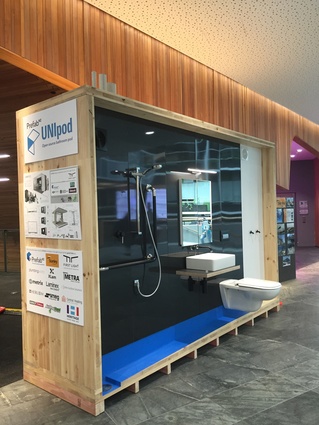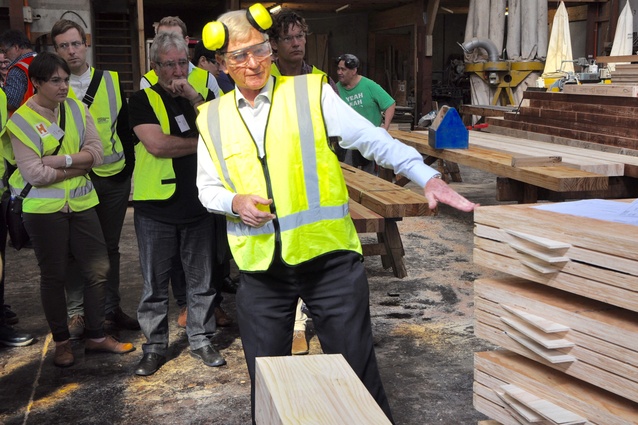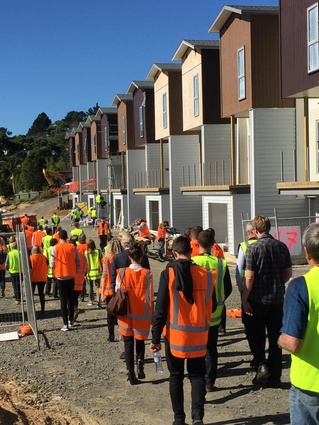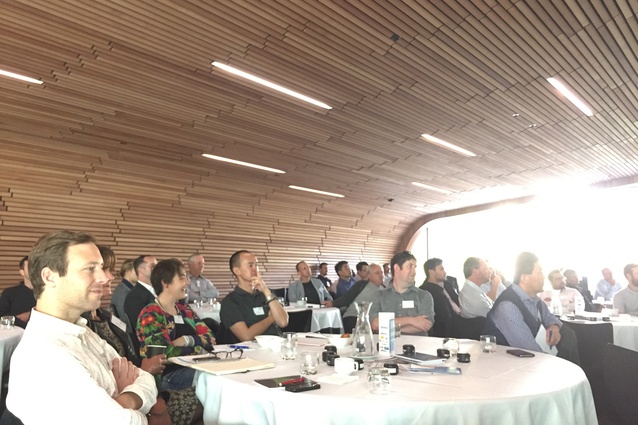Collaboration + innovation
The 2016 PrefabNZ CoLab event took place from 6–8 April at AUT in Auckland. CoLab is an annual interactive event that highlights innovative design and construction methods focusing on offsite/prefab projects.
Wednesday 6 April was the CoLab Site Visit Day to four interesting and varied examples of prefabrication. First up was ABT Construction’s three-storey terraced houses in Albany. These houses are built using Axxis Steel Framing in a combination of traditional on-site construction for the ground floor and modular off-site (factory built) construction for upper levels.
Site two was the TimberLab headquarters in East Tamaki where visitors could see how to create engineered timber, observing a huge computer numerically controlled (CNC) machine in action, cutting and drilling laminated veneer lumber (LVL) for large scale buildings. Is this the start of New Zealand’s opportunity to create large buildings with timber instead of steel?

Next up was a tour of Ko Awatea, an educational facility at Middlemore Hospital designed by Jasmax to be completely relocatable. Much of the building was built off-site, with extensive BIM modelling to coordinate prefabrication of the elements.
The final visit of the day was to a Housing NZ RightSize project in Mangere East with Stanley Construction, looking at innovative two-bedroom infill homes and extensions that were brought to site as bathroom pods and panels and were erected in just one day. Other innovations in this compact design included the one-piece insulated metal panel roof / ceiling / soffit system.
Thursday 7 April was the Conference Day at AUT’s inspiring Sir Paul Reeves Building in Auckland. Deputy Mayor Penny Hulse kicked off the day by launching the UNIpod, cutting the ribbon of the prototype open-source bathroom-kitchen pod that was designed by First Light Studio following a PrefabNZ design competition in late 2015.
There were entertaining, instructive and provocative presentations throughout the day from a range of speakers. Highlights were many, including keynote speaker Scott Hedges of Lindbäcks, Sweden, who presented an informative talk on one of the most advanced house factories in Europe. The fact that one wall can be manufactured in 17 minutes inside their sophisticated factory gave a lot of food for thought.
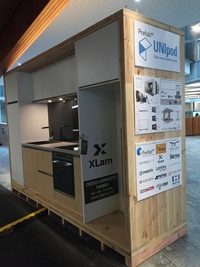
Keynote Shamubeel Eaqub amused the crowd with his many references to baby boomers and talk of revolution in addressing the rather more serious topic of our unaffordable housing crisis and the issues facing Generation Rent. Makers of Architecture’s Beth Cameron gave a compelling talk that encouraged more innovation and discussed how the company utilises 3D models and the latest CNC technology to create flexible prefab building systems.
Towards the end of the day, Frances Valintine, an education futurist from The Mind Lab, showed us images of the near-future and allowed us to imagine a world where “data is the new oil” and our future buildings will be highly connected and trackable.
Other equally interesting speakers on the day included Anna Farrow of First Light Studio, Wellington; Warren McGregor, CEO of PrefabAUS; Christina van Bohemen of Bohemen Sills Architects and incoming President of the New Zealand Institute of Architects; Daniel Scheibmair of Pryda; Julian Watt of Jasmax; Yusef Patel of The University of Auckland and James McNicholas and Azmon Chetty, formerly of Unitec.
The day concluded with drinks and the launch of the PrefabNZ HIVE book, along with a presentation by Pat Shepherd (Spinning Top / One Percent Collective) on inspiring a generosity movement in New Zealand. Pat’s captivating photography and videos speak of a values-based system that compliments the hard-nosed economics of the day’s proceedings.
On Friday, there was a half-day Members session starting with breakfast. This included an update from PrefabNZ letting members know about their new website which will be launched in a few months’ time, advising on next steps for UNIpod and take-aways from the conference.
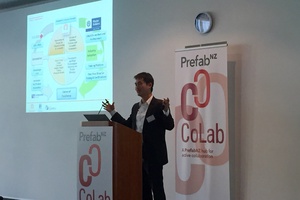
The final presentations included a talk from Tuan Doc Ngo from the University of Melbourne’s Architecture School, who commented on the large multi-million dollar investment from their federal government to work alongside industry and academic players to grow the local prefabrication industry as the automobile manufacturers withdraw.
MBIE’s Laura Sinclair updated the audience on the impending release of the Manufactured Building Systems Guidance which goes some way to clarify building consent processes for prefabricated building parts, and David Chandler of Western Sydney University expanded his position on how prefab businesses need to do more work to identify their market gap prior to start-up.
The final day ended with a World Cafe style session with a keynote speaker and board member on each table so that members could engage in more in-depth conversations. Tables were rotated every 15 minutes to enable all attendees to meet with the keynotes.
The 2016 CoLab was a fun, successful and engaging event, with a range of talks and activities that illustrated the passion, innovation and collaboration that is behind the quickly-growing prefabrication industry in New Zealand. Prefabrication’s viability to address the medium-density housing market in Auckland was a key focus and an area to watch in the coming months and years.
CoLab presentations are available for PrefabNZ members here.


